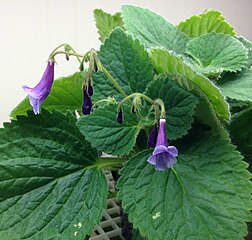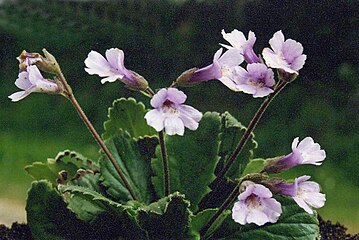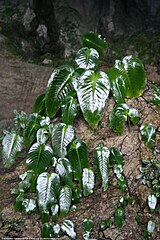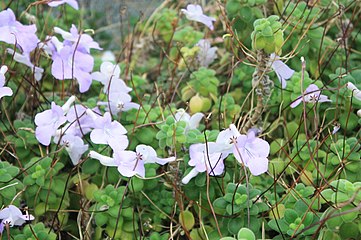Didymocarpoideae: Difference between revisions
→References: citation style |
removed Category:Plant subfamilies; added Category:Asterid subfamilies using HotCat |
||
| (13 intermediate revisions by 3 users not shown) | |||
| Line 4: | Line 4: | ||
| image_caption = ''Cyrtandra grayi'' |
| image_caption = ''Cyrtandra grayi'' |
||
| taxon = Didymocarpoideae |
| taxon = Didymocarpoideae |
||
| authority = Arn. |
| authority = Arn.<ref name=Reve11/><ref name=WebeMiddClarMoll20/> |
||
| display_parents = 3 |
| display_parents = 3 |
||
| synonyms = |
| synonyms = |
||
| Line 10: | Line 10: | ||
The '''Didymocarpoideae''' are a subfamily of plants in the family [[Gesneriaceae]]. It was formerly the subfamily '''Cyrtandroideae'''. This subfamily consists mostly of [[Tropics|tropical]] and [[Subtropics|subtropical]] Old World genera, found in Africa, Asia and the Pacific. One species (''[[Rhynchoglossum azureum]]'') is native to Central and South America.<ref name=WebeMiddClarMoll20/> |
The '''Didymocarpoideae''' are a subfamily of plants in the family [[Gesneriaceae]]. It was formerly the subfamily '''Cyrtandroideae'''. This subfamily consists mostly of [[Tropics|tropical]] and [[Subtropics|subtropical]] Old World genera, found in Africa, Asia and the Pacific. One species (''[[Rhynchoglossum azureum]]'') is native to Central and South America.<ref name=WebeMiddClarMoll20/> |
||
==Description== |
|||
Didymocarpoideae is one of two main subfamilies in the Gesneriaceae, the other being [[Gesnerioideae]]. (The third subfamily, Sanangoideae, contains only the genus ''[[Sanango]]''.) Didymocarpoideae seedlings usually have [[cotyledon]]s which become different in size and shape (anisocotylous). One cotyledon ceases to grow at some point and then withers away. The other continues to grow, and in extreme cases may grow to become very large and be the only leaf on the plant (''[[Monophyllaea]]'', some ''[[Streptocarpus]]''). Didymocarpoideae flowers usually have two fertile [[stamen]]s, less often four and rarely one or five. The [[Ovary (botany)|ovary]] is always superior. The fruit is usually a dry capsule, although other kinds of fruit, such as a fleshy berry, are also found.<ref name=WebeMiddClarMoll20/> |
|||
==Tribes and genera== |
==Tribes and genera== |
||
A classification published in 2020 divides the subfamily into two tribes.<ref name=WebeMiddClarMoll20/> |
|||
*Tribe Epithemateae |
* Tribe Epithemateae |
||
{{Div col|colwidth= |
{{Div col|colwidth=12em|style=padding-left:18px}} |
||
* ''[[Epithema]]'' |
|||
* ''[[Gyrogyne]]'' |
|||
* ''[[Loxonia]]'' |
|||
* ''[[Monophyllaea]]'' |
|||
* ''[[Rhynchoglossum]]'' |
|||
* ''[[Stauranthera]]'' |
|||
* ''[[Whytockia]]'' |
|||
{{Div col end}} |
{{Div col end}} |
||
*Tribe Trichosporeae |
* Tribe Trichosporeae |
||
{{Div col|colwidth= |
{{Div col|colwidth=12em|style=padding-left:18px}} |
||
* ''[[Aeschynanthus]]'' |
|||
* ''[[Agalmyla]]'' |
|||
* ''[[Allocheilos]]'' |
|||
* ''[[Allostigma]]'' |
|||
* ''[[Anna (plant)|Anna]]'' |
|||
* ''[[Beccarinda]]'' |
|||
* ''[[Billolivia]]'' |
|||
* ''[[Boea]]'' |
|||
* ''[[Boeica]]'' |
|||
* ''[[Briggsiopsis]]'' |
|||
* ''[[Cathayanthe]]'' |
|||
* ''[[Championia]]'' |
|||
* ''[[Chayamaritia]]'' |
|||
* ''[[Codonoboea]]'' |
|||
* ''[[Conandron]]'' |
|||
* ''[[Corallodiscus]]'' |
|||
* ''[[Cyrtandra (plant)|Cyrtandra]]'' |
|||
* ''[[Damrongia]]'' |
|||
* ''[[Deinostigma]]'' |
|||
* ''[[Didissandra]]'' |
|||
* ''[[Didymocarpus]]'' |
|||
* ''[[Didymostigma]]'' |
|||
* ''[[Dorcoceras]]'' |
|||
* ''[[Emarhendia]]'' |
|||
* ''[[Glabrella]]'' |
|||
* ''[[Gyrocheilos]]'' |
|||
* ''[[Haberlea]]'' |
|||
* ''[[Hemiboea]]'' |
|||
* ''[[Henckelia]]'' |
|||
* ''[[Hexatheca]]'' |
|||
* ''[[Jerdonia (plant)|Jerdonia]]'' |
|||
* ''[[Kaisupeea]]'' |
|||
* ''[[Leptoboea]]'' |
|||
* ''[[Liebigia]]'' |
|||
* ''[[Litostigma]]'' |
|||
* ''[[Loxocarpus]]'' |
|||
* ''[[Loxostigma]]'' |
|||
* ''[[Lysionotus]]'' |
|||
* ''[[Metapetrocosmea]]'' |
|||
* ''[[Microchirita]]'' |
|||
* ''[[Middletonia (plant)|Middletonia]]'' |
|||
* ''[[Orchadocarpa]]'' |
|||
* ''[[Oreocharis (plant)|Oreocharis]]'' |
|||
* ''[[Ornithoboea]]'' |
|||
* ''[[Paraboea]]'' |
|||
* ''[[Petrocodon]]'' |
|||
* ''[[Petrocosmea]]'' |
|||
* ''[[Platystemma]]'' |
|||
* ''[[Primulina]]'' |
|||
* ''[[Pseudochirita]]'' |
|||
* ''[[Rachunia]]'' |
|||
* ''[[Ramonda (plant)|Ramonda]]'', including ''Jankaea'' |
|||
* ''[[Raphiocarpus]]'' |
|||
* ''[[Rhabdothamnopsis]]'' |
|||
* ''[[Rhynchotechum]]'' |
|||
* ''[[Ridleyandra]]'' |
|||
* ''[[Senyumia]]'' |
|||
* ''[[Sepikea]]'' |
|||
* ''[[Somrania]]'' |
|||
* ''[[Spelaeanthus]]'' |
|||
* ''[[Streptocarpus]]'', including ''Saintpaulia'' |
|||
* ''[[Tetraphyllum]]'' (syn. ''Tetraphylloides'') |
|||
* ''[[Tribounia]]'' |
|||
{{div col end}} |
{{div col end}} |
||
<gallery mode=packed heights=160px> |
|||
File:Aeschynanthus.jpg|''[[Aeschynanthus speciosus]]'' |
|||
File:Cyrtandra cyaneoides (5490666621).jpg|''[[Cyrtandra cyaneoides]]'' |
|||
File:Damrongia-orientalis Roberts.jpg|''[[Damrongia orientalis]]'' |
|||
File:Haberlea rhodopensis.jpg|''[[Haberlea rhodopensis]]'' |
|||
File:Microchirita lavandulacea (Chirita lavandulacea) - Botanischer Garten, Dresden, Germany - DSC08590.JPG|''[[Microchirita lavandulacea]]'' |
|||
File:Monophyllaea glauca.jpg|''[[Monophyllaea glauca]]'' – each leaf is one separate plant |
|||
File:Petrocosmea rosettifolia.JPG|''[[Petrocosmea rosettifolia]]'' |
|||
File:RAMONDA MYCONI - LA CORRIU - IB-467 (Orella d'ós).JPG|''[[Ramonda myconi]]'' |
|||
File:KlugiaWynaad.jpg|''[[Rhynchoglossum notonianum]]'' |
|||
File:Streptocarpus saxorum in bloom.jpg|''[[Streptocarpus saxorum]]'' |
|||
</gallery> |
|||
==Distribution== |
|||
The species of the subfamily Didymocarpoideae are native to Europe, Africa, Asia, [[Malesia]], the [[Pacific Ocean|Pacific]] and [[Australia]], except for a single species, ''[[Rhynchoglossum azureum]]'', which is native to the [[Neotropical realm|Neotropics]] (Central and South America).<ref name=WebeMiddClarMoll20/> |
|||
== References == |
== References == |
||
{{reflist|refs= |
{{reflist|refs= |
||
<ref name=Reve11>{{Citation |last1=Reveal |first1=James L. |date=2011 |orig-year=onwards |contribution=Didymocarpoideae |title=Indices Nominum Supragenericorum Plantarum Vascularium |publisher=Plant Biology section, Cornell University |contribution-url=http://www.plantsystematics.org/reveal/pbio/fam/allspgfileD.html |url=http://www.plantsystematics.org/reveal/pbio/fam/allspgnames.html |access-date=2021-04-14 }}</ref> |
|||
| ⚫ | <ref name=WebeMiddClarMoll20>{{Citation |last1=Weber |first1=A. |last2=Middleton |first2=D.J. |last3=Clark |first3=J.L. |last4=Möller |first4=M. |date=2020 |title=Keys to the infrafamilial taxa and genera of Gesneriaceae |journal=Rheedea |volume=30 |issue=1 |pages=5–47 |doi=10.22244/rheedea.2020.30.01.02 |name-list-style=amp }}</ref> |
||
| ⚫ | <ref name=WebeMiddClarMoll20>{{Citation |last1=Weber |first1=A. |last2=Middleton |first2=D.J. |last3=Clark |first3=J.L. |last4=Möller |first4=M. |date=2020 |title=Keys to the infrafamilial taxa and genera of Gesneriaceae |journal=Rheedea |volume=30 |issue=1 |pages=5–47 |doi=10.22244/rheedea.2020.30.01.02 |name-list-style=amp |doi-access=free }}</ref> |
||
}} |
}} |
||
== |
==External links== |
||
* {{commonscat inline|Didymocarpoideae|"Didymocarpoideae"}} |
* {{commonscat inline|Didymocarpoideae|"Didymocarpoideae"}} |
||
* {{wikispecies inline}} |
* {{wikispecies inline}} |
||
{{taxonbar|from1=Q21234240|from2=Q5795565}} |
{{taxonbar|from1=Q21234240|from2=Q5795565}} |
||
[[Category: |
[[Category:Didymocarpoideae]] |
||
[[Category: |
[[Category:Asterid subfamilies]] |
||
[[Category:Plant subfamilies]] |
|||
[[Category:Flora of Africa]] |
|||
Latest revision as of 22:51, 3 May 2024
| Didymocarpoideae | |
|---|---|

| |
| Cyrtandra grayi | |
| Scientific classification | |
| Kingdom: | Plantae |
| Clade: | Tracheophytes |
| Clade: | Angiosperms |
| Clade: | Eudicots |
| Clade: | Asterids |
| Clade: | Lamiids |
| Order: | Lamiales |
| Family: | Gesneriaceae |
| Subfamily: | Didymocarpoideae Arn.[1][2] |
The Didymocarpoideae are a subfamily of plants in the family Gesneriaceae. It was formerly the subfamily Cyrtandroideae. This subfamily consists mostly of tropical and subtropical Old World genera, found in Africa, Asia and the Pacific. One species (Rhynchoglossum azureum) is native to Central and South America.[2]
Description[edit]
Didymocarpoideae is one of two main subfamilies in the Gesneriaceae, the other being Gesnerioideae. (The third subfamily, Sanangoideae, contains only the genus Sanango.) Didymocarpoideae seedlings usually have cotyledons which become different in size and shape (anisocotylous). One cotyledon ceases to grow at some point and then withers away. The other continues to grow, and in extreme cases may grow to become very large and be the only leaf on the plant (Monophyllaea, some Streptocarpus). Didymocarpoideae flowers usually have two fertile stamens, less often four and rarely one or five. The ovary is always superior. The fruit is usually a dry capsule, although other kinds of fruit, such as a fleshy berry, are also found.[2]
Tribes and genera[edit]
A classification published in 2020 divides the subfamily into two tribes.[2]
- Tribe Epithemateae
- Tribe Trichosporeae
- Aeschynanthus
- Agalmyla
- Allocheilos
- Allostigma
- Anna
- Beccarinda
- Billolivia
- Boea
- Boeica
- Briggsiopsis
- Cathayanthe
- Championia
- Chayamaritia
- Codonoboea
- Conandron
- Corallodiscus
- Cyrtandra
- Damrongia
- Deinostigma
- Didissandra
- Didymocarpus
- Didymostigma
- Dorcoceras
- Emarhendia
- Glabrella
- Gyrocheilos
- Haberlea
- Hemiboea
- Henckelia
- Hexatheca
- Jerdonia
- Kaisupeea
- Leptoboea
- Liebigia
- Litostigma
- Loxocarpus
- Loxostigma
- Lysionotus
- Metapetrocosmea
- Microchirita
- Middletonia
- Orchadocarpa
- Oreocharis
- Ornithoboea
- Paraboea
- Petrocodon
- Petrocosmea
- Platystemma
- Primulina
- Pseudochirita
- Rachunia
- Ramonda, including Jankaea
- Raphiocarpus
- Rhabdothamnopsis
- Rhynchotechum
- Ridleyandra
- Senyumia
- Sepikea
- Somrania
- Spelaeanthus
- Streptocarpus, including Saintpaulia
- Tetraphyllum (syn. Tetraphylloides)
- Tribounia
-
Monophyllaea glauca – each leaf is one separate plant
Distribution[edit]
The species of the subfamily Didymocarpoideae are native to Europe, Africa, Asia, Malesia, the Pacific and Australia, except for a single species, Rhynchoglossum azureum, which is native to the Neotropics (Central and South America).[2]
References[edit]
- ^ Reveal, James L. (2011) [onwards], "Didymocarpoideae", Indices Nominum Supragenericorum Plantarum Vascularium, Plant Biology section, Cornell University, retrieved 2021-04-14
- ^ a b c d e Weber, A.; Middleton, D.J.; Clark, J.L. & Möller, M. (2020), "Keys to the infrafamilial taxa and genera of Gesneriaceae", Rheedea, 30 (1): 5–47, doi:10.22244/rheedea.2020.30.01.02
External links[edit]
 Media related to "Didymocarpoideae" at Wikimedia Commons
Media related to "Didymocarpoideae" at Wikimedia Commons Data related to Didymocarpoideae at Wikispecies
Data related to Didymocarpoideae at Wikispecies










